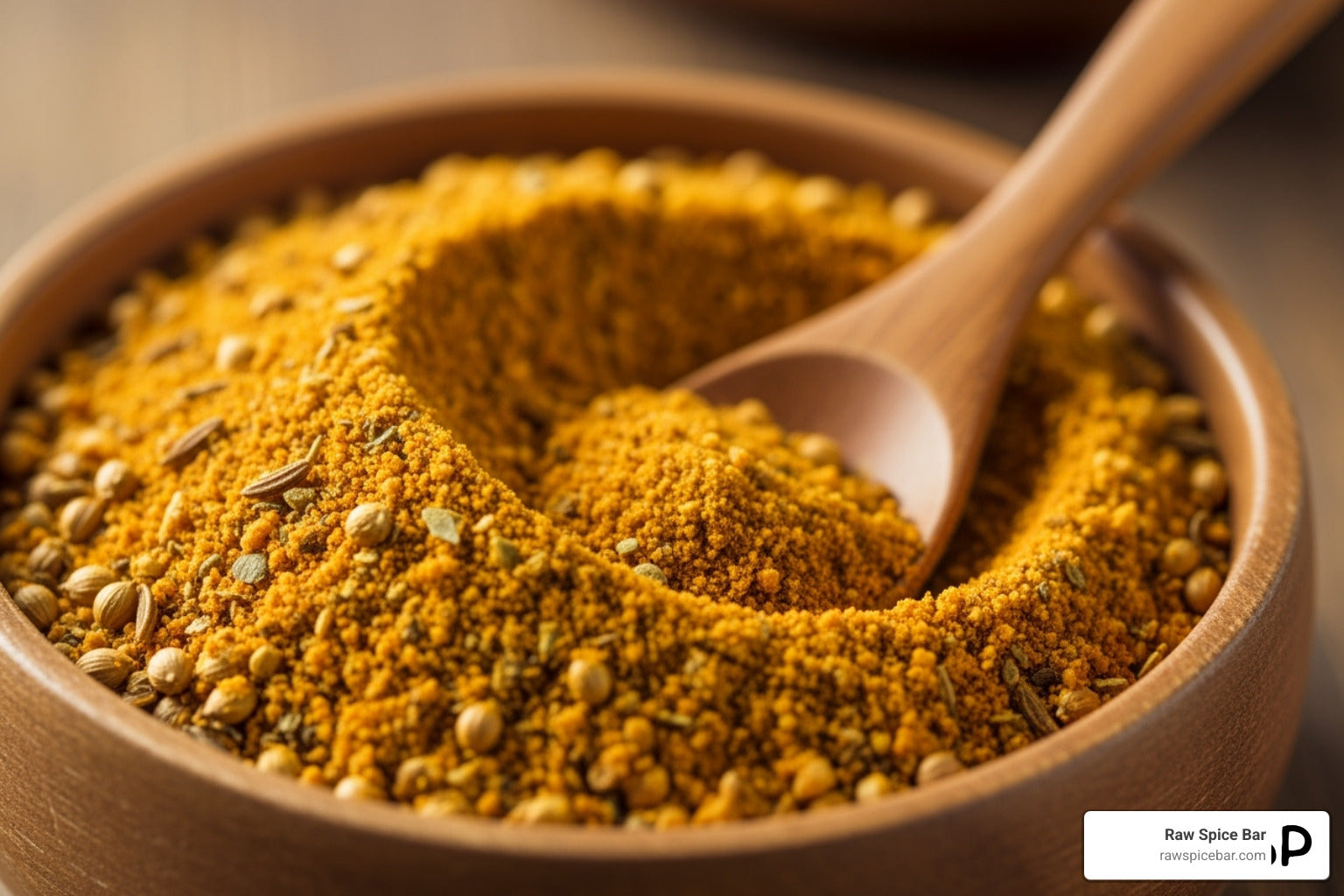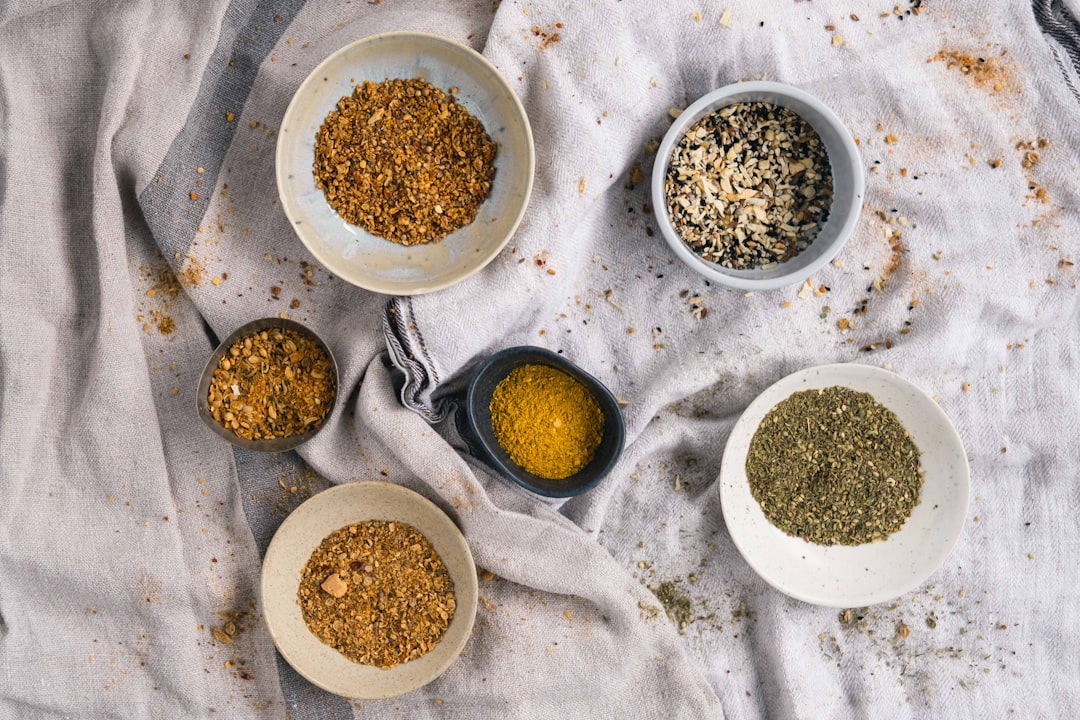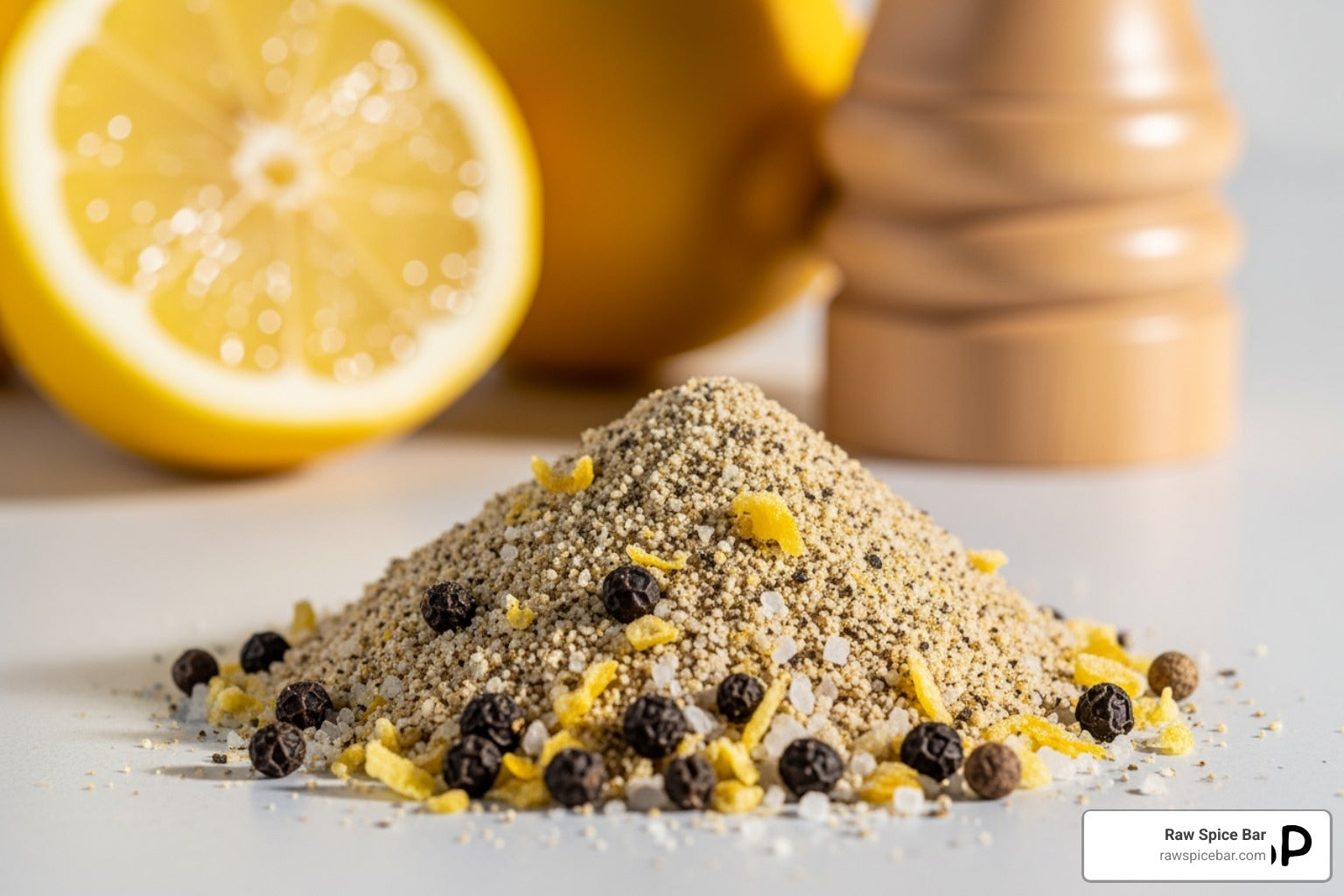The Pantry Predicament: When Chili Powder Goes Missing
Paprika chili powder substitute situations happen to the best of us. You're halfway through making your favorite chili recipe when you find an empty spice jar where your chili powder should be. Don't panic - paprika can save the day.
Quick Answer: Can paprika replace chili powder?
- Yes, but with adjustments - Use 1:1 ratio of sweet paprika
- Add missing flavors - Mix in cumin, garlic powder, and oregano
- Control the heat - Use hot paprika for spiciness, sweet paprika for mild dishes
- Avoid smoked paprika - Unless you want a smoky flavor change
It's Tuesday night, and you've gathered all the ingredients for tonight's slow cooker mac and cheese. Well, almost all the ingredients - after searching and searching, your head drops as you pick up an empty container marked "paprika" and finally remember what you went to the store for earlier (it was paprika, not the other 10 things you grabbed).
This common kitchen crisis doesn't have to derail your dinner plans. Paprika makes an excellent chili powder substitute when you understand the key differences and know how to adjust your recipe.
The main difference? Chili powder is a spice blend containing paprika, cumin, garlic powder, and other seasonings. Paprika is a single ground pepper that provides the color and base flavor. With a few simple tweaks, you can bridge that gap.
As Joseph Rosenblatt, founder of a premium spice company, I've helped countless home cooks master the art of paprika chili powder substitute techniques through years of recipe development and spice blending. This guide will show you exactly how to make the swap work perfectly in your kitchen.
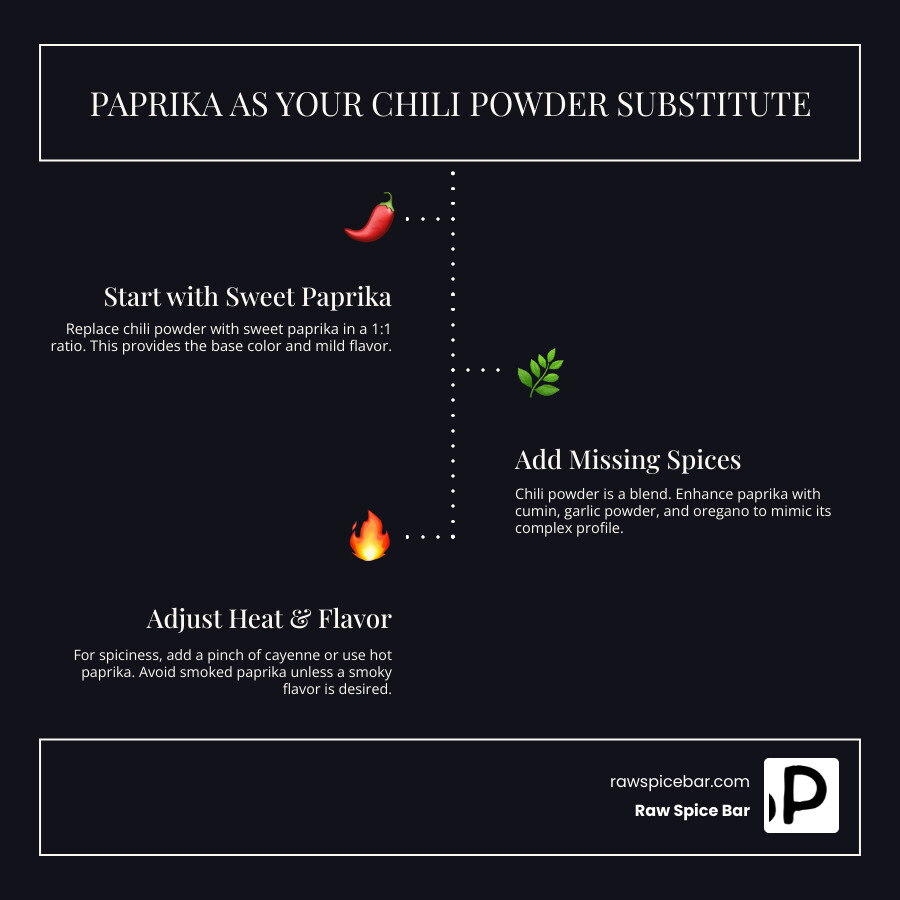
Easy paprika chili powder substitute glossary:
Paprika vs. Chili Powder: Understanding the Key Differences
When you're looking for a paprika chili powder substitute, you're essentially trying to replace a whole orchestra with a single violin. While both spices bring that beautiful red color to your dishes, they're completely different players in the spice world.
Think of it this way: chili powder is like a pre-made spice blend that someone carefully crafted for you, while paprika is a single, pure ingredient waiting to be part of something bigger. This fundamental difference is exactly why your substitution can work beautifully - you just need to know how to build that orchestra back up.
Paprika vs. Chili Powder: Understanding the Spice Spectrum
What is Chili Powder?
Here's where things get interesting: that familiar red powder in your spice rack labeled "chili powder" isn't actually just ground chili peppers. It's a carefully crafted spice blend designed to give you complex, layered flavors in one convenient shake.
Most commercial chili powders contain paprika as their base (which is why this substitution works so well!), but they also include cumin for that earthy, warm depth, garlic powder for savory richness, onion powder for sweetness, oregano for herbal notes, and cayenne pepper for the heat that makes your taste buds dance.
This blend creates an earthy flavor profile that can range from mild and sweet to fiery hot, depending on the brand. Some chili powders lean smoky, others are more sweet, and some pack serious heat. It's like having a whole spice cabinet in one jar.
There's also an important distinction to know about: "chili powder" versus "chile powder." The difference between "chili powder" and "chile powder" is that chile powder (with an 'e') refers to a single type of ground pepper, like ancho or chipotle. The 'i' version is the blend we're talking about here.
What is Paprika?
Paprika takes a completely different approach - it's a single ingredient made from grinding dried Capsicum annuum peppers. But don't let that simplicity fool you. This one ingredient comes in several varieties that can transform your cooking in different ways.
Sweet paprika is probably sitting in your spice rack right now. It's made from sweet red peppers and gives you that gorgeous color with a mild, slightly fruity flavor and virtually no heat. It's perfect when you want the visual impact without the fire.
Hot paprika brings the heat while keeping that distinctive paprika flavor. It's spicier than sweet paprika but usually more gentle than pure cayenne pepper.
Then there's smoked paprika (called pimentón in Spain), which is a game-changer. These peppers are slowly dried over wood smoke for up to two weeks, creating an intense, deep smoky flavor that can completely transform a dish. Where Does Paprika Come From and How Is It Made?
Hungarian paprika deserves special mention - it's the national spice of Hungary and comes in eight different categories ranging from mild and sweet to fiery hot. It's the star ingredient in traditional dishes like chicken paprikash.
| Type of Paprika | Flavor Profile | Heat Level (SHU Estimate) | Best Culinary Uses |
|---|---|---|---|
| Sweet | Mild, fruity, slightly sweet | 0-100 SHU | Garnishing, mild dishes, adding color |
| Hot | Peppery with noticeable heat | 1,000-8,000 SHU | Spicy dishes, when you want heat with paprika flavor |
| Smoked (Pimentón) | Deep, smoky, complex | 500-1,000 SHU | BBQ, stews, when you want smoky depth |
Understanding these differences is key to successful paprika chili powder substitute cooking. You're not just swapping one red powder for another - you're choosing which flavor profile will work best for your specific dish.
How to Use Paprika as a Chili Powder Substitute
Now that we understand chili powder is a blend and paprika is a single spice, let's dive into the practical magic of using paprika chili powder substitute techniques. The secret isn't just swapping one for the other - it's about rebuilding that complex flavor profile that makes chili powder so special.
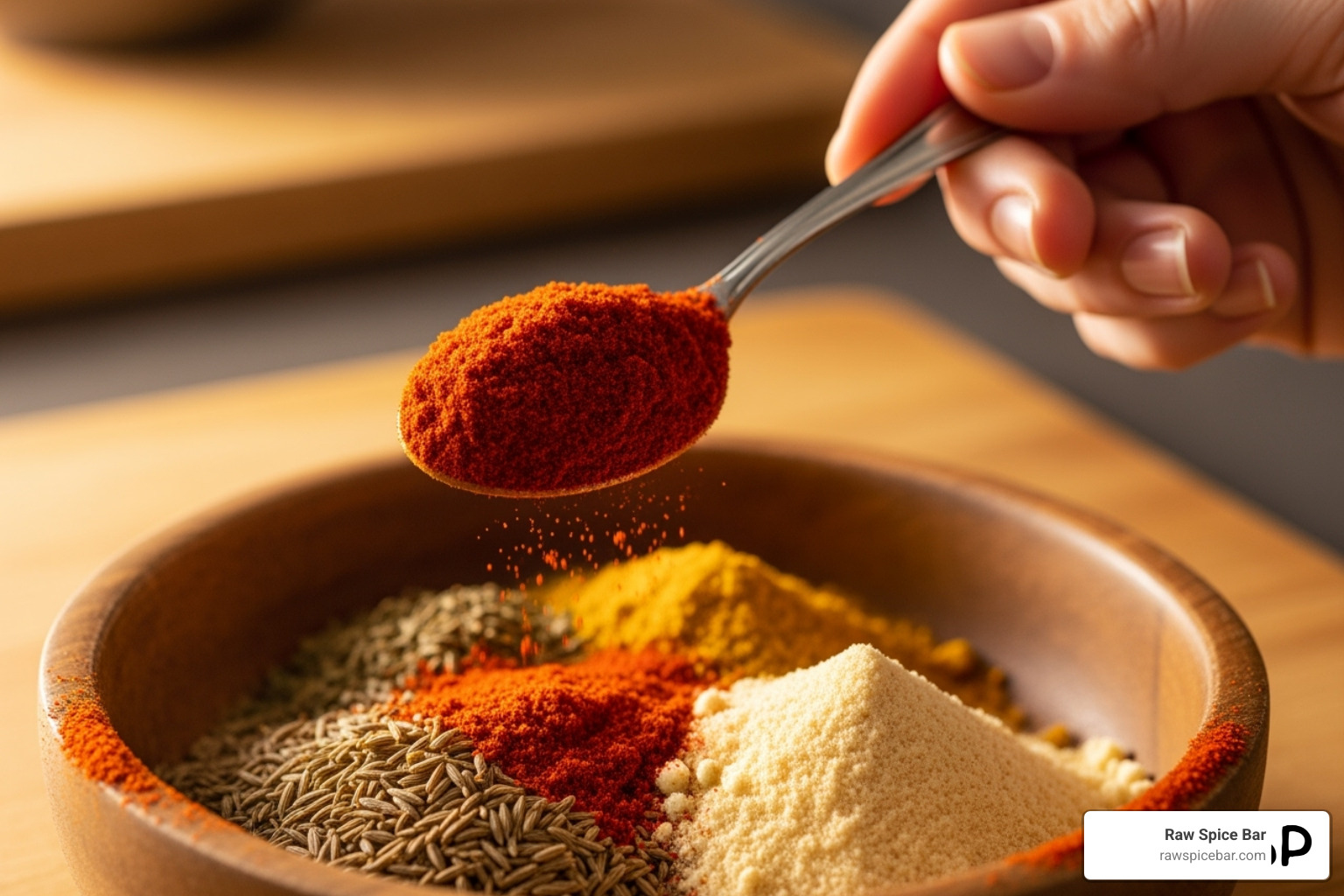
Think of it like this: if chili powder is a symphony, paprika is just the lead violin. Beautiful on its own, but it needs the supporting orchestra to create that full, rich sound your taste buds are expecting.
The golden rule? Start with equal amounts of paprika to replace your missing chili powder, then build the flavor from there. Your taste buds are your best guide - start conservatively, taste as you go, and adjust until you hit that perfect note.
Making the Swap: A Guide to Using Paprika as a Chili Powder Substitute
When your recipe calls for chili powder and you're reaching for paprika instead, here's how to make that paprika chili powder substitute work beautifully:
Begin with your paprika base. Use a 1:1 ratio - one tablespoon of paprika for every tablespoon of chili powder your recipe needs. Sweet paprika works perfectly for most dishes, while hot paprika gives you a head start on heat if your recipe is meant to have some kick.
Add the earthy backbone with cumin. This is where the magic happens. Cumin provides that warm, earthy depth that makes chili powder so distinctive. Mix in about ½ teaspoon of ground cumin for every tablespoon of paprika you're using.
Build savory complexity with garlic powder and onion powder. These aromatics add the savory foundation that paprika alone can't provide. A ½ teaspoon of each per tablespoon of paprika usually does the trick.
Round out with oregano. A pinch of dried oregano (about ¼ teaspoon) brings that herbaceous note that's especially important in Mexican and Tex-Mex dishes.
Control the heat carefully. If you're using sweet paprika and need some fire, add cayenne pepper gradually. Start with just a ¼ teaspoon - cayenne is potent, and you can always add more but you can't take it back!
Best Substitute for Chili Powder: Spice Up Your Dish Without Missing a Beat
The beauty of this approach is the complete control you have over your final flavor. You can customize your homemade blend to match your family's preferences or the specific needs of your dish.
When is Paprika the Best Chili Powder Substitute?
Paprika chili powder substitute techniques work brilliantly in several cooking situations:
Mild recipes are where paprika truly shines. When you're making a gentle chicken rub or garnishing deviled eggs, sweet paprika delivers that gorgeous color and subtle pepper flavor without overwhelming delicate ingredients.
Color-critical dishes benefit enormously from paprika's vibrant red hue. If you're making a stew that needs to look as good as it tastes, or that Instagram-worthy slow cooker mac and cheese, paprika will give you that rich, appealing color that makes food look irresistible.
Heat control becomes effortless when you build your own blend. This is perfect for families where some like it hot and others prefer mild - you can adjust the cayenne to suit everyone's taste.
Dry rubs and marinades are ideal candidates for paprika-based substitutions. Since these applications often involve multiple spices anyway, paprika can form the colorful, flavorful base while you add other seasonings to create your perfect blend.
Paprika: The Ultimate Dry Rub Must-Have
When to Avoid Using Smoked Paprika
Here's where we need to pump the brakes on our paprika chili powder substitute enthusiasm. Smoked paprika might seem like an exciting option, but it's usually not the right choice for general chili powder substitution.
Smoked paprika has an * distinctive flavor* that can completely transform your dish. Those peppers are dried over oak wood smoke for up to two weeks, creating a deep, unmistakable smokiness that's absolutely delicious - but only when you want it.
Imagine making your family's favorite beef chili recipe, expecting those familiar warm, earthy flavors, only to have it taste like liquid smoke. That's what happens when smoked paprika's overpowering flavor takes over a dish that wasn't designed for it.
The specific smoky taste of smoked paprika works wonderfully in dishes that call for it, but it's not a neutral substitute for regular chili powder. Save it for recipes that specifically want that campfire essence, and stick with sweet or hot paprika for your general substitution needs.
Substitutes for Smoked Paprika in Cooking
DIY Spice Blends: Creating Your Own Chili Powder
There's something magical about creating your own spice blends. Not only does it solve the "empty jar" crisis, but it also puts you in complete control of your flavors. When you understand how to use paprika chili powder substitute techniques, you're essentially learning to build your own custom chili powder from scratch.
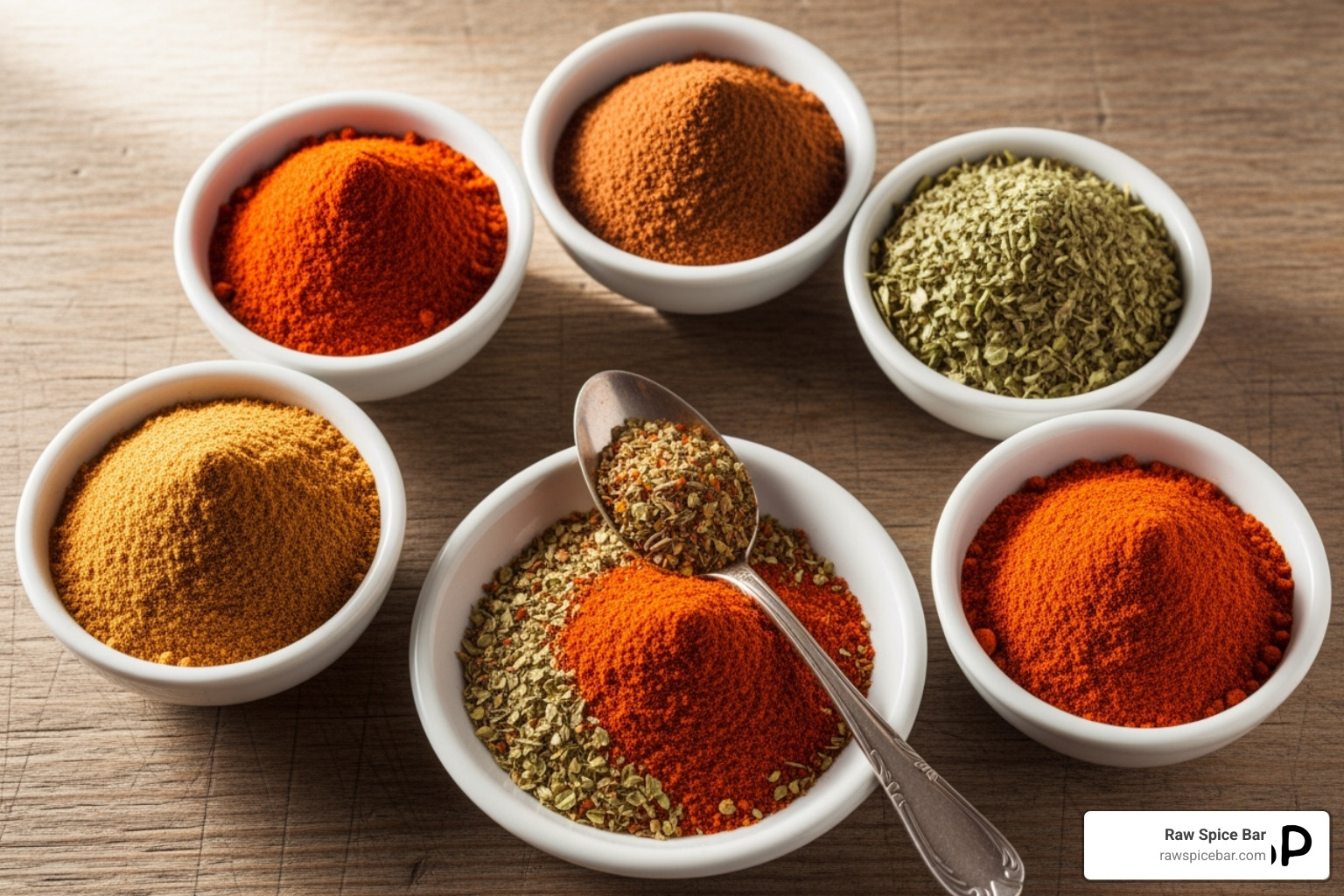
Making your own chili powder is like being a conductor of an orchestra - each spice plays its part to create something beautiful together. The best part? Your homemade blend will likely taste fresher and more vibrant than anything you can buy at the store. Plus, you'll know exactly what's going into your food.
Simple Homemade Chili Powder Recipe
This recipe uses paprika as the star ingredient, then builds out all those familiar flavors we expect from good chili powder. Think of paprika as your foundation - everything else just adds to its natural goodness.
Here's what you'll need:
- 3 parts sweet paprika - This is your base, providing that gorgeous red color and mild, fruity flavor
- 1 part ground cumin - The earthy, warm backbone that makes chili powder taste like, well, chili powder
- 1 part garlic powder - Adds that savory depth we all love
- 1 part onion powder - Brings a subtle sweetness that rounds everything out
- ½ part dried oregano - Essential for that authentic Tex-Mex flavor
- Pinch of cayenne pepper (optional) - Your heat control knob - start small and add more if you're feeling brave
Mixing is simple: Combine everything in a small bowl and whisk until evenly distributed. If "1 part" equals 1 tablespoon, you'd use 3 tablespoons of paprika, 1 tablespoon each of cumin, garlic powder, and onion powder, plus ½ tablespoon of oregano and just a tiny pinch of cayenne.
Storage tips are straightforward - keep your blend in an airtight container away from sunlight and heat. Like all ground spices, it's best used within 3-6 months for peak flavor. We recommend making smaller batches more often rather than huge quantities that might lose their punch over time.
Missing Chili Powder? Here's Exactly What to Use Instead
The beauty of this approach is that you can adjust the recipe to match your taste preferences. Want more heat? Add extra cayenne. Prefer it milder? Skip the cayenne entirely. This flexibility makes your paprika chili powder substitute blend truly your own.
Other Common Spice Swaps
While paprika is an excellent paprika chili powder substitute, sometimes you might find yourself in another spice predicament. Perhaps you're out of paprika, or maybe you need a chili powder alternative that isn't paprika-based. Don't worry - we've got you covered!
Having a well-stocked spice rack is like having a toolbox full of flavor solutions. The more alternatives you know, the more confident you'll feel when that inevitable "Oh no, I'm out of..." moment strikes.
Top 3 Substitutes for Chili Powder (Besides Paprika)
When paprika isn't available or you want to try something different, these alternatives will save your recipe:
Taco seasoning is your closest ready-made friend. It's practically chili powder's cousin, sharing many of the same ingredients like paprika, cumin, oregano, and garlic powder. Use it in a 1:1 ratio, but watch out - most taco seasonings contain salt, so you might need to dial back the salt elsewhere in your recipe. Some brands pack more heat than others, so taste as you go.
Ancho chili powder brings something special to the table. Made from dried poblano peppers, it offers a mild, fruity flavor with gentle smoky notes. This single-origin chile powder is perfect when you want depth without overwhelming heat. Start with about half the amount your recipe calls for, since pure ancho can be more potent than blended chili powder. You'll still want to add cumin, garlic powder, and oregano to round out the flavor. Best Ancho Chili Powder Substitute
Cayenne pepper is your heat-only hero. If chili powder's main job in your recipe is adding spice, cayenne delivers pure fire. But here's where you need to be careful - cayenne is significantly hotter than most chili powders. Start with just a tiny pinch (1/4 to 1/2 teaspoon for every tablespoon of chili powder) and taste before adding more. Cayenne only brings heat, so you'll need to add cumin, garlic powder, and oregano separately for that complete chili powder flavor. Best Cayenne Pepper Substitute
Top 3 Substitutes for Paprika
What happens when paprika itself goes missing? These alternatives will keep your cooking on track, whether you need color, mild flavor, or that specific pepper essence:
Ancho pepper powder steps in beautifully for paprika, especially when you want that mild, earthy flavor with subtle smoky notes. Since it's made from dried poblano peppers, it shares paprika's gentle nature while adding its own character. You can usually use it in a 1:1 ratio for sweet paprika, just account for those lovely smoky undertones.
Tomato powder might surprise you, but it's a fantastic paprika substitute, especially for color. It brings a mild, sweet, umami flavor that works wonderfully in many dishes. Use it in a 1:1 ratio for beautiful color and subtle flavor improvement. If your recipe needs heat, you'll need to add a pinch of cayenne separately.
Bell pepper powder is essentially paprika's mild-mannered cousin. Made from dried and ground bell peppers (usually red ones), it gives you that perfect sweet pepper flavor and vibrant color without any heat. It's ideal when you want paprika's color and mild taste but need to keep things completely heat-free. Use it in a 1:1 ratio - it's basically pure Capsicum annuum powder, just like paprika, but from the sweetest varieties.
The beauty of understanding these swaps is that you're never truly stuck. Each substitute brings its own personality to your dish, sometimes even improving on the original recipe in unexpected ways.
Frequently Asked Questions about Paprika and Chili Powder
We get tons of questions about these two kitchen staples from home cooks just like you. Let's tackle the most common ones and give you the confidence to make these swaps like a pro!
Can I use hot paprika instead of chili powder?
Absolutely! Hot paprika is actually a fantastic choice for your paprika chili powder substitute, especially when you want that spicy kick. It brings more heat to the table than sweet paprika, getting you much closer to the warmth you'd expect from traditional chili powder.
Here's the thing though - hot paprika is still just one spice doing one job. It delivers the heat and that gorgeous red color, but it's missing the supporting cast that makes chili powder so complex. You won't get those earthy cumin notes, the savory depth from garlic powder, or the herbaceous touch of oregano.
Think of hot paprika as your lead singer - it's got the power and presence, but you still need the backup band to make beautiful music. Add some cumin and garlic powder to round out the flavor, and you'll have a winning combination.
Paprika vs. Cayenne: What's the Difference?
Will using paprika change the color of my dish?
Not in any way that'll disappoint you! Both paprika and chili powder are the heroes of the red spice world, so your dish will keep that beautiful, appetizing color you're after. In fact, paprika might even give you a more vibrant red than some chili powders.
Paprika is actually the go-to spice when chefs want that stunning red hue. It's what gives Hungarian goulash its gorgeous color and makes deviled eggs look so appealing. The exact shade might vary slightly depending on whether you're using sweet, hot, or smoked paprika, but you're looking at subtle differences, not dramatic changes.
Your slow cooker mac and cheese will still look just as mouthwatering, and your chili will have that rich, inviting color that makes everyone gather around the pot.
How much paprika should I use to replace 1 tablespoon of chili powder?
This is the question that keeps coming up in our inbox! The magic formula starts with 1 tablespoon of sweet paprika as your base, then we build from there.
Add ½ teaspoon of cumin for that essential earthy warmth, ½ teaspoon of garlic powder for savory depth, and ½ teaspoon of onion powder for a touch of sweetness. A small pinch of dried oregano (about ¼ teaspoon) brings in those herbaceous notes.
If you need heat, start with just ¼ teaspoon of cayenne pepper and taste before adding more. Cayenne is no joke - it packs serious heat, and you can always add more but you can't take it back!
The most important advice we can give you? Taste as you go! Every chili powder brand is different, and your taste buds are the best judge of what works for your dish. Start with our formula, then adjust until it tastes just right to you. This way, you'll never end up with a dish that's too bland or too spicy for your family's preferences.
Conclusion: Spice Up Your Cooking with Confidence
We've taken quite a journey through the colorful world of spices together! From understanding why your paprika chili powder substitute works so well to mastering the art of building your own custom blends, you now have the confidence to tackle any spice emergency that comes your way.
The beauty of cooking lies in these moments of findy. When you first realized that empty chili powder container didn't have to derail dinner, you open uped something powerful - the ability to adapt and create. Paprika isn't just a pretty garnish sitting on your deviled eggs anymore. It's a versatile foundation that, with a few simple additions, transforms into exactly what your recipe needs.
Think about how empowering this knowledge is. You now understand that chili powder is simply a blend of spices you probably already have. Sweet paprika provides the base and color, cumin brings that essential earthiness, and garlic powder adds the savory depth. A pinch of oregano and optional cayenne pepper complete the picture. It's like having a secret recipe that works every single time.
The most important lesson? Always taste as you go. Your palate is your best teacher, and every dish is a chance to fine-tune your skills. Some nights you might want extra heat, other times you'll prefer a milder touch. That's the beauty of creating your own blends - you're in complete control.
At Raw Spice Bar, we've seen countless home cooks transform their kitchens once they understand these fundamental spice relationships. Our monthly subscription brings you freshly packed, globally inspired spice blends precisely because we believe cooking should be an trip, not a source of stress. From Japanese seven-spice to Mediterranean herb blends, each month opens up new possibilities for your culinary creativity.
Every great cook started exactly where you are now - curious, willing to experiment, and ready to learn. That empty spice jar that seemed like a problem? It was actually an opportunity to expand your skills and confidence in the kitchen.
So go ahead, accept those pantry predicaments. Armed with your new paprika chili powder substitute knowledge and a willingness to taste and adjust, you're ready to create delicious meals no matter what surprises your spice rack has in store. Happy cooking, and here's to many more flavorful trips ahead!



